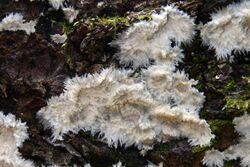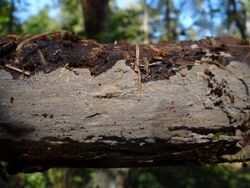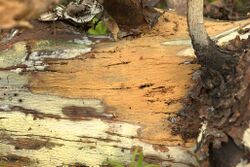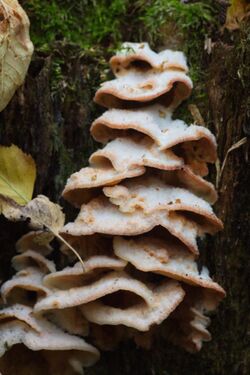Biology:Phlebia
| Phlebia | |
|---|---|

| |
| Phlebia radiata | |
| Scientific classification | |
| Domain: | Eukaryota |
| Kingdom: | Fungi |
| Division: | Basidiomycota |
| Class: | Agaricomycetes |
| Order: | Polyporales |
| Family: | Meruliaceae |
| Genus: | Phlebia Fr. (1821) |
| Type species | |
| Phlebia radiata Fr. (1821)
| |
| Species | |
|
86, see text | |
| Synonyms[1] | |
| |
Phlebia is a genus of mostly crust fungi in the family Meruliaceae. The genus has a widespread distribution.[3] Phlebia species cause white rot.
Taxonomy
Phlebia was circumscribed by Swedish mycologist Elias Fries in his 1821 work Systema Mycologicum. He included four species: P. merismoides, P. radiata, P. contorta, and P. vaga.[4]
Several molecular studies have demonstrated that Phlebia is a collection of sometimes unrelated taxa that share some morphological similarities.[5][6] In a 2015 study, Floudas and Hibbett identified a "core Phlebia clade" within the larger Phlebioid clade, containing P. radiata, P. acerina, P. floridensis, P. setulosa, P. brevispora, and P. tremellosa.[7] A subsequent study suggested that P. lindtneri, P. serialis and P. leptospermi should be added to this core group.[6]
Phlebia-like fungi with aculei (spines) are often included in the genera Mycoacia if they are monomitic, and Mycoaciella if they are dimitic or trimitic.[8]
Species





(As of May 2018), Index Fungorum accepts 89 species of Phlebia:[9]
- P. anthocystis Gilb. & Nakasone (1998)[10] – Hawaii
- P. acerina Peck (1889)[11]
- P. alni Velen. (1922)
- P. amylostratosa Svrček (1973)
- P. ardesiaca Parmasto (1967)
- P. argentea Parmasto (1967)
- P. argentina (Speg.) Rajchenb. & J.E.Wright (1987)
- P. argentinensis W.B.Cooke (1956)[12]
- P. brevibasidia G.Kaur, Avn.P. Singh & Dhingra (2017) – Punjab, India[13]
- P. brevispora Nakasone (1981)[14]
- P. brunneofusca (Hjortstam & Ryvarden) Nakasone & Gilb. (1998)[10]
- P. canadensis W.B.Cooke (1956)[12]
- P. capitata Bernicchia & Gorjón (2010)
- P. caspica Hallenb. (1980)
- P. castanea Lloyd (1922)
- P. celtidis W.B.Cooke (1956)[12]
- P. centrifuga P.Karst. (1881)
- P. cinnamomea Rick (1960)
- P. citrea (Pat.) Nakasone (2003)
- P. coccineofulva Schwein. (1832)
- P. columellifera (G.Cunn.) Duhem (2009)
- P. crassisubiculata Avn.P. Singh, Priyanka, Dhingra & Singla (2010) – Himachal Pradesh, India[15]
- P. cristata Velen. (1922)
- P. cystidiata H.S.Jacks. ex W.B.Cooke (1956)[12]
- P. diaphana Parmasto ex K.H.Larss. & Hjortstam (1986)
- P. dictyophoroides Sang H.Lin & Z.C.Chen (1990)
- P. diffissa J.Erikss. & Hjortstam (1981)
- P. donkii Bourdot (1930)[16]
- P. epithelioides P.Roberts (2000)[17] – Cameroon
- P. faviformis W.B.Cooke (1958)
- P. femsjoeensis (Litsch. & S.Lundell) J.Erikss. & Hjortstam (1981)
- P. firma J.Erikss. & Hjortstam (1981)[18]
- P. flavocrocea (Bres.) Donk (1957)
- P. floridensis Nakasone & Burds. (1995)[19] – United States
- P. formosana Sheng H.Wu (1990)[20] – Taiwan
- P. fragilis (G.Cunn.) Gorjón & Gresl. (2012)
- P. gilbertsonii Nakasone (1997)[21]
- P. griseoflavescens (Litsch.) J.Erikss. & Hjortstam (1981) – Europe
- P. griseolivens (Bourdot & Galzin) Parmasto (1967)
- P. hydnoidea Schwein. (1832)
- P. icterina P.Roberts (2000)[17] – Cameroon
- P. introversa (Rehill & B.K.Bakshi) Hjortstam (1995)
- P. jurassica Duhem & M.Duenas (2013)[22] – Europe
- P. lacteola (Bourdot) M.P.Christ. (1960) – Great Britain
- P. leptospermi (G.Cunn.) Stalpers (1985)[23] – Western Australia
- P. lilascens (Bourdot) J.Erikss. & Hjortstam (1981) – Europe
- P. livida (Pers.) Bres. (1897) – Africa; Europe; North America
- P. lividina Hjortstam (1995) – South Carolina, USA
- P. ludoviciana (Burt) Nakasone & Burds. (1982)
- P. margaritae Duhem & H.Michel (2007)[24]
- P. merulioides Lloyd (1915)[25]
- P. moelleriana Henn. (1897)[26]
- P. murrillii W.B.Cooke (1956)[12]
- P. nantahaliensis Nakasone & Burds. (1995)[19]
- P. nitidula (P.Karst.) Ryvarden (1971)
- P. pallidolivens (Bourdot & Galzin) Parmasto (1967)
- P. parva Ghob.-Nejh. (2012)
- P. patriciae Gilb. & Hemmes (2004)[27] – Hawaii
- P. pellucida Hjortstam & Ryvarden (1988)[28] – China
- P. phlebioides (H.S.Jacks. & Dearden) Donk (1957)
- P. plumbea Parmasto (1967)
- P. pulcherrima Parmasto (1967)
- P. pyrenaica Duhem (2009)[29]
- P. radiata Fr. (1821)
- P. rhodana Duhem & B.Rivoire (2014)[22]
- P. rufa (Pers.) M.P.Christ. (1960) – Europe; Jamaica
- P. ryvardenii Hallenb. & Hjortstam (1988)[30]
- P. scarlatina J.A. Cooper (2023)[31]
- P. sedimenticola (S.Ahmad) S.Ahmad (1972)
- P. segregata (Bourdot & Galzin) Parmasto (1967) – Europe
- P. separata (H.S.Jacks. & Dearden) Parmasto (1967)
- P. serialis (Fr.) Donk (1957) – Sweden
- P. sordida Rick (1938)[32] – South America
- P. subceracea (Wakef.) Nakasone (2003) – Australia
- P. subconspersa (Rick) Baltazar & Rajchenb. (2016)
- P. subfascicularis (Wakef.) Nakasone & Gilb. (1998)[10] – Australia
- P. sublilascens (Litsch.) Parmasto (1967)
- P. sublivida Parmasto (1967)
- P. subochracea (Alb. & Schwein.) J.Erikss. & Ryvarden (1976) – Europe
- P. subserialis (Bourdot & Galzin) Donk (1957) – Europe
- P. subulata J.Erikss. & Hjortstam (1981)[18]
- P. totara (G.Cunn.) Stalpers & P.K.Buchanan (1991)
- P. tremellosa (Schrad.) Nakasone & Burds. (1984)
- P. tuberculata (Berk. & M.A.Curtis) Ţura, Zmitr., Wasser & Spirin (2011)
- P. unica (H.S.Jacks. & Dearden) Ginns (1984)
- P. verruculosa Hjortstam & Ryvarden (1980)[33]
- P. vinosa (Overh.) Burds. (1990)
- P. viridesalebrosa J.Erikss. & Hjortstam (1981)[18] – Europe
- P. weldeniana Nakasone & Burds. (1995)[19]
- P. wrightii (Berk. & M.A.Curtis) Duhem (2010)
References
- ↑ Phlebia Fr. 1821. MycoBank. International Mycological Association. http://www.mycobank.org/MycoTaxo.aspx?Link=T&Rec=18250. Retrieved 2011-11-27.
- ↑ Persoon, C.H. (1825) (in la). Mycologia Europaea. 2. p. 7. http://www.cybertruffle.org.uk/cyberliber/37012/0007.htm.
- ↑ Kirk, P.M.; Cannon, P.F.; Minter, D.W.; Stalpers, J.A. (2008). Dictionary of the Fungi (10th ed.). Wallingford, UK: CAB International. p. 522. ISBN 978-0-85199-826-8.
- ↑ Fries, E.M. (1821) (in la). Systema Mycologicum. 1. Lundin: Ex Officina Berlingiana. p. 426. https://biodiversitylibrary.org/page/4338566.
- ↑ de Koker, Theodorus H.; Nakasone, Karen K.; Haarhof, Jacques; Burdsall Jr, Harold H.; Janse, Bernard J.H. (2003). "Phylogenetic relationships of the genus Phanerochaete inferred from the internal transcribed spacer region". Mycological Research 107 (9): 1032–1040. doi:10.1017/S095375620300827X. PMID 14563129. https://www.fpl.fs.fed.us/documnts/pdf2003/koker03a.pdf.
- ↑ 6.0 6.1 Kuuskeri, Jaana; Mäkelä, Miia R.; Isotalo, Jarkko; Oksanen, Ilona; Lundell, Taina (2015). "Lignocellulose-converting enzyme activity profiles correlate with molecular systematics and phylogeny grouping in the incoherent genus Phlebia (Polyporales, Basidiomycota)". BMC Microbiology 15: 217. doi:10.1186/s12866-015-0538-x. PMID 26482661.

- ↑ Floudas, Dimitrios; Hibbett, David S. (2015). "Revisiting the taxonomy of Phanerochaete (Polyporales, Basidiomycota) using a four gene dataset and extensive ITS sampling". Fungal Biology 119 (8): 679–719. doi:10.1016/j.funbio.2015.04.003. PMID 26228559.
- ↑ Zíbarová, Lucie (2017). "Notes on corticioid fungi of the Czech Republic. I. Phlebia acanthocystis and Phlebia bispora (Meruliaceae)". Czech Mycology 69 (1): 65–76. doi:10.33585/cmy.69105. http://www.czechmycology.org/_cmo/CM69105.pdf.

- ↑ Kirk, P.M.. "Species Fungorum (version 28th March 2018). In: Species 2000 & ITIS Catalogue of Life". http://www.catalogueoflife.org/col/browse/tree/id/bde0dc0f437398338d9a712455a962e6.
- ↑ 10.0 10.1 10.2 Nakasone, K.K.; Gilbertson, R.L. (1998). "Three resupinate hydnaceous basidiomycetes from Hawaii". Folia Cryptogamica Estonica 33: 85–92.
- ↑ Peck, C.H. (1889). "Report of the Botanist (1888).". Annual Report on the New York State Museum of Natural History 42: 101–144.
- ↑ 12.0 12.1 12.2 12.3 12.4 Cooke, W.B. (1956). "The genus Phlebia". Mycologia 48 (3): 386–405. doi:10.1080/00275514.1956.12024546. http://www.cybertruffle.org.uk/cyberliber/59350/0048/003/0386.htm.
- ↑ Kaur, Gurpreet; Singh, Avneet P.; Dhingra, G.S. (2017). "Phlebia brevibasidia sp. nov. from India". Mycotaxon 132 (1): 95–97. doi:10.5248/132.95.
- ↑ Nakasone, K.K.; Eslyn, W.E. (1981). "A new species, Phlebia brevispora, a cause of internal decay in utility poles". Mycologia 73 (5): 803–811. doi:10.2307/3759792.
- ↑ Singh, Avneet P.; G.S. Dhingra, Priyanka; Singla, Nishi (2010). "A new species of Phlebia (Basidiomycetes) from India". Mycotaxon 112: 21–24. doi:10.5248/112.21.
- ↑ Donk, M.A. (1930). "Nederlandse Basidiomyceten I.". Nederlandsch Kruidkundig Archief. 3 1940 (1): 65–84. http://natuurtijdschriften.nl/download?type=document&docid=548799.
- ↑ 17.0 17.1 Roberts, P. (2000). "Corticioid fungi from Korup National Park, Cameroon". Kew Bulletin 55 (4): 803–842. doi:10.2307/4113628.
- ↑ 18.0 18.1 18.2 Eriksson, J.; Hjortstam, K.; Ryvarden, L. (1981). The Corticiaceae of North Europe. 6. Phlebia – Sarcodontia. Oslo: Fungiflora. pp. 1048–1276.
- ↑ 19.0 19.1 19.2 Nakasone, Karen K.; Burdsall, Harold H. Jr. (1995). "Phlebia species from Eastern and Southeastern United States". Mycotaxon 54: 335–359. http://www.cybertruffle.org.uk/cyberliber/59575/0054/0335.htm.
- ↑ Wu, S.H. (1990). "The Corticiaceae (Basidiomycetes) subfamilies Phlebioideae, Phanerochaetoideae and Hyphodermoideae in Taiwan". Acta Botanica Fennica 142: 27. http://www.gbv.de/dms/bs/toc/016022963.pdf.
- ↑ Nakasone, K.K. (1997). "Studies in Phlebia. Six species with teeth". Sydowia 49 (1): 49–79. https://www.zobodat.at/pdf/Sydowia_49_0049-0079.pdf.
- ↑ 22.0 22.1 Duhem, B. (2013). "Phlebia rhodana sp. nov. et Phlebia jurassica sp. nov (Agaricomycotina), deux espèces nouvelles de France avec hyménophore tuberculé" (in fr). Cryptogamie, Mycologie 34 (4): 291–301. doi:10.7872/crym.v34.iss4.2013.291.
- ↑ Stalpers, J.A. (1985). "Type studies of the species of Corticium described by G.H. Cunningham". New Zealand Journal of Botany 23 (2): 301–310. doi:10.1080/0028825X.1985.10425332.
- ↑ Duhem, B.; Michel, H. (2007). "Une espèce nouvelle de Phlebia possédant des fibres arboriformes" (in fr). Cryptogamie, Mycologie 28 (1): 29–38.
- ↑ Lloyd, C.G. (1915). "Mycological Notes 39". Mycological Writings 4 (39): 525–540.
- ↑ Hennings, P. (1897). "Beiträge zur Pilzflora Südamerikas. II" (in de). Hedwigia 36: 190–246.
- ↑ Gilbertson, R.L.; Hemmes, D.E. (2004). "New species of lignicolous basidiomycetes from Hawaii". Memoirs of the New York Botanical Garden 89: 81–92.
- ↑ Hjortstam, K.; Ryvarden, L. (1988). "Notes on the Corticiaceae of northern China". Acta Mycologica Sinica 7 (2): 77–88.
- ↑ Duhem, Bernard (2009). "Phlebia pyrenaica sp. nov., une nouvelle espèce méditerranéenne" (in fr). Cryptogamie, Mycologie 30 (4): 319–328.
- ↑ Hallenberg, N.; Hjortstam, K. (1988). "Studies in Corticiaceae (Basidiomycetes): new species and new combinations". Mycotaxon 31 (2): 439–443.
- ↑ "Specimen Details Phlebia scarlatina". https://scd.landcareresearch.co.nz/Specimen/PDD_49237.
- ↑ Rick, J. (1938). "Monografia das poliporineas Riograndenses" (in es). Brotéria Série Trimestral: Ciências Naturais 7: 5–21.
- ↑ Hjortstam, K.; Ryvarden, L. (1980). "Studies in tropical Corticiaceae (Basidiomycetes). II". Mycotaxon 12 (1): 168–184.
Wikidata ☰ Q2712219 entry
 |

